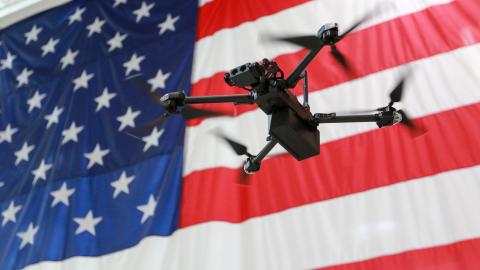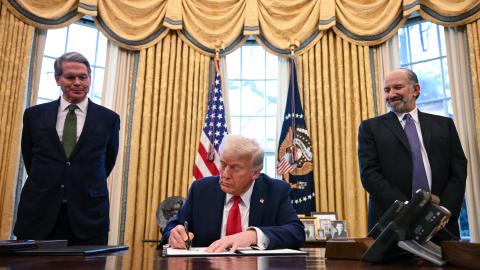**North Korea has a missile that can reach the United States. Many North Korea watchers have believed this for some time, especially since its successful satellite launch in February of last year. The technology for a satellite launch is directly transferable to a long-range missile launch. But on America’s Independence Day, the Kim Jong-un regime successfully flight-tested an intercontinental ballistic missile (ICBM), so there’s no speculation at this point.**
North Korea can probably put a nuclear warhead on an ICBM, too, but we don’t know for sure. U.S. military commanders have said it can likely do so, and that the United States has to plan for it. So, what are our realistic options at this point?
First, what we cannot accept: the United States simply lives with the possibility that North Korea could launch a nuclear missile at the American people. The effects of this are hard to overstate. It would mean that the United States population was effectively hostage to North Korea. Whatever the United States wanted to do abroad or at home, whatever any U.S. official said or did, would have to be weighed against the possibility of Pyongyang deciding it warranted a nuclear strike. The nuclear gun would be loaded and cocked. And the one who held that gun would be an evil madman who murders his own relatives on a whim, starves his own people, and has death camps so big we can see them from space.
It has been the policy for every American president, Democrat and Republican, to forbid and prohibit North Korea from having that capability. It was President Obama’s position, and it is President Trump’s.
Some are calling for diplomacy. Former officials—including William Perry, former Secretary of Defense under Bill Clinton, and George Shultz, who was Secretary of State under Ronald Reagan—jointly wrote a letter urging talks. It’s a nice thought. But the letter’s most useful purpose is to serve as a reminder that even aged and knowledgeable “experts” don’t necessarily have the best advice. The United States has tried diplomacy—for two decades. Not only did it not stop the North’s nuclear ambitions, it aided them. Secretary of State Rex Tillerson has acknowledged that the time for talks passed before the current administration and that it won’t be the method President Trump pursues.
This is the right take. North Korea wants talks (and sanctions relief). But after a string of U.N. Security Council violations and after its officials killed American citizen, college student Otto Warmbier, giving North Korea what it wants would incentivize it to do more of the same. Of course, other regimes would be watching and learning as well.
There are three things the United States should do.
One, immediately squeeze China. If China wants to continue to pay lip service about forcing North Korea to freeze and roll back its nuclear missile program while actually increasing trade with the world’s leading proliferator of missile technology, the United States should make it pay. Because Beijing doesn’t perceive North Korea’s missiles as its problem, the United States should make it its problem. The U.S. Treasury Department has recently begun doing exactly this. It announced last month that it would be sanctioning, among other Chinese entities, China’s Bank of Dandong. This is a must because China is North Korea’s enabler. Trade with Beijing accounts for 90 percent of North Korea’s trade. But sanctioning China carries with it a cost. The President has several foreign policy objectives he must weigh when dealing with China, including trade, but taking away North Korea’s nuclear missile program outweighs them all.
Two, the United States must ramp up missile defense investments, increase its inventory of these defensive systems, and deploy them as soon as they come online. Now that the United States has proven the technology for these systems, there is no good, moral argument not to deploy them. The alternative is to allow Americans and our allies to remain vulnerable to Kim’s missiles and his moral strictures (and, the lack thereof). Having the ability to intercept even a portion of what North Korea could launch at the United States or our allies could deter North Korea from even thinking an attack would be worth the cost. Especially when combined with nuclear and conventional offensive weapons, missile defense would serve as a deterrent. But if North Korea did launch an attack, the United States must have defensive capabilities in place.
The U.S. ballistic missile defense system (BMDS) is comprised of several different kinds of systems that each intercept different missile types with specific ranges. The Terminal High Altitude Area Device (THAAD) is the one the Obama administration decided, with the South Korea government, to deploy to South Korea. The new South Korean president, Moon Jae-in, has delayed the deployment. There are more than 28,000 American troops and their families deployed in South Korea, so it would be a strategic and moral failure not to complete THAAD’s deployment, which would provide the region with an effective defense. Just this week the United States successfully tested the THAAD system, intercepting its 14th missile—this one an intermediate range ballistic missile—out of 14 tests.
THAAD is not the only system that has been making impressive technical progress. The Aegis weapon system is the sea-based element of the BMDS, and it’s one on which the United States cooperates with Japan. Notably, President Bush deployed the Aegis weapon system to intercept the burnt-out satellite that was careening toward earth in 2008 in an operation dubbed “Operation Burnt Frost.” The United States should continue to invest in this program, increase inventory of its SM-3 interceptors, and aggressively test the program, not making resources contingent on successful tests. Even missed intercepts are useful, and the United States can apply what is learned from missed tests. (This is exactly how the North Koreans have made progress on their missile program. Note, those who laughed when North Korea’s launches blew up on the launch pad, had a short time to do so.)
The Ground-based Midcourse Defense (GMD) system is the only missile defense system deployed to protect the United States from long-range missiles. It also had a very successful intercept test recently, intercepting an ICBM-class target for the first time. The successful test earned it an upgrade in status from the hard-to-please Office of Test and Evaluation (DOT&E). Military Commanders have repeatedly expressed confidence in the system, and the country should invest in it to ensure that confidence only increases. President Obama cut the program’s budget in half during the early years of his administration. President Trump should restore that funding and increase the inventory of Ground-based Interceptors (GBIs) so that the nation has more “bullets” to shoot at incoming missiles.
Along with sea-based and ground-based missile defense systems, the United States must have a more robust space layer. Space is the ultimate high ground. America currently has two satellites deployed, called the Space Tracking and Surveillance Systems (STSS). Those satellites have been enormously successful. But they’re aging, and we need more than two. Having a more substantial space sensor layer, leveraging new technology, would give the United States what is called “birth-to-death” tracking of enemy missiles. This would increase the reliability of kills. In addition to sensors, the United States must have a kill capability that is space-based. Space-based interceptors would give the United States the ability to intercept enemy missiles while they are boosting, that is, while they are still over their own territory and before they can release decoys and counter-measures meant to trick the U.S. defensive system. Not only would this dramatically boost the reliability of the entire system against North Korean missiles, it would also give the United States protection against some of what the Chinese and Russians are building and deploying to threaten the United States.
Three, the United States should continue evaluating options to take out North Korea’s nuclear missile program and its conventional artillery. The North’s artillery already holds South Korea hostage, and it’s the main reason the United States hasn’t already moved militarily to take out the missile program. Acting militarily against North Korea risks escalating a larger war there and—worst case scenario, if it escalates enough—a conflict with China. As Secretary of Defense James Mattis said, “if this goes to a military solution, it is going to be tragic on an unbelievable scale.” This is why the North must understand that if need be the United States is prepared to do it. North Korea won’t end up on the winning side of a war with the United States. But it will put up a bloody, merciless fight, and it’s one the United States doesn’t want to have. To convince Pyongyang that Washington is willing, the United States should not back down on its military drills in the region.
There are several very serious international threats facing the United States, but North Korea is the one that poses the gravest and most immediate threat. None of the options before the Trump administration are great, but previous presidents have kicked the can down the road for long enough, and, as Charles Krauthammer succinctly observed, we are now “out of road.”

















